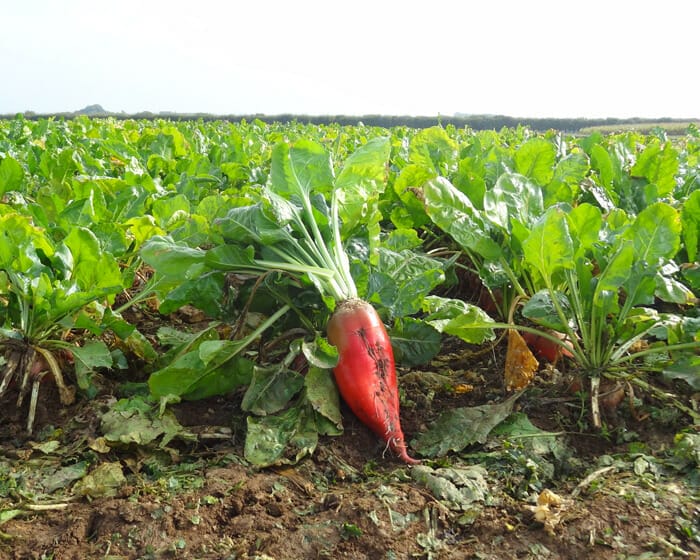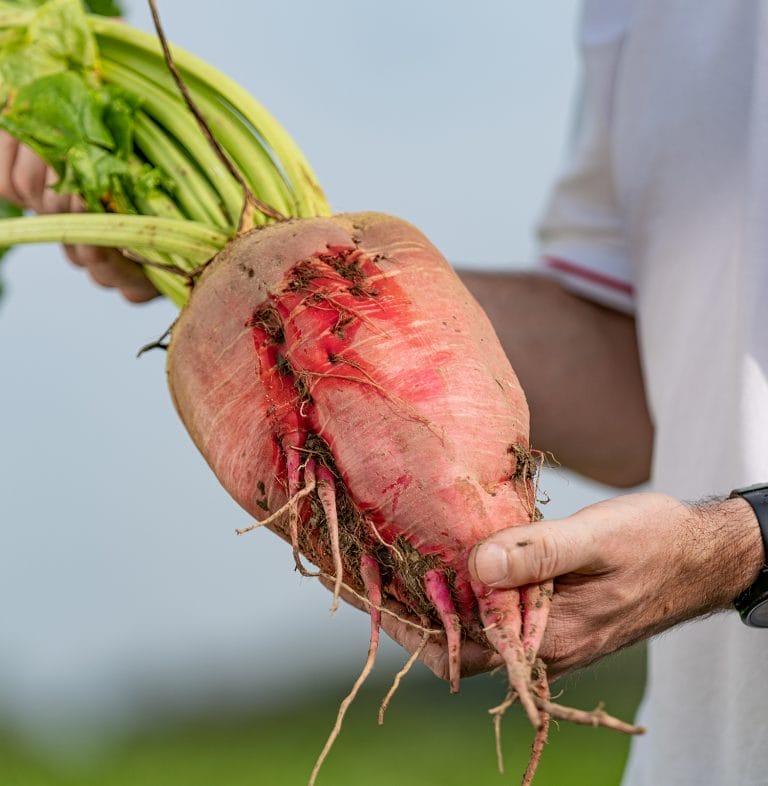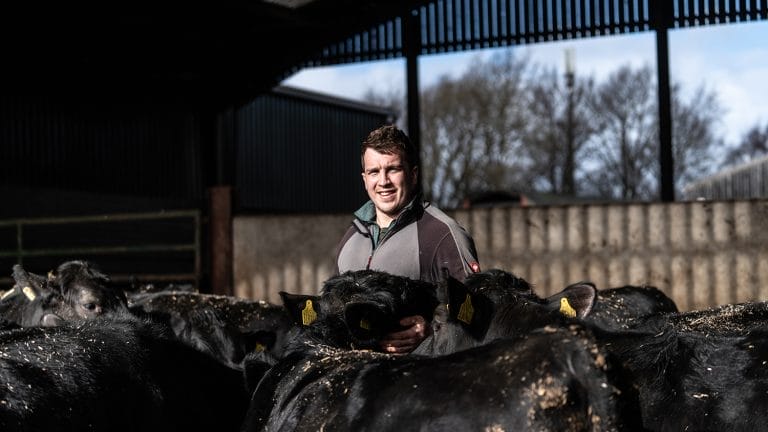He grazes between 100 to 120 dairy cattle, mainly in-calf heifers, from mid November until late March on the crop, that he feeds with grass silage. “The cattle thrive on it and they are especially healthy,” says Phil, who runs the 320-cow three way cross herd near Oswestry in partnership with his parents Roy and Morfydd and with three full time staff and four part time casuals.

Dairy Farmer and Milk Producer, Phil James
Short on housing space and land around the dairy, Phil needed to look at fodder crops that he could graze, on out-lying land. “We tried kale, but this grew too tall to graze youngstock in. We also tried a type of rape hybrid that was popular at the time, but that didn’t give us the feed value we were looking for,” he says.
Next he tried Blaze fodder beet. “It was third time lucky. This worked well for us and it gave us what we wanted in terms of feed value.”
And it’s a good solution for over-wintering his in-calf heifers in this autumn calving system. “The grazing platform around the dairy unit is limited to just 40 hectares and it’s reserved for the milking herd – we need it all for the cows,” he adds.
The only ‘downside’ Phil’s found with over-wintering heifers outdoors, is encouraging them to use the cubicles when they’ve calved. “I think we need to train them well before they calve down – I’m sure they’ll then get the hang of it.”
About 200ha of out-lying land growsmaize and grass for silage and the 6ha of fodder beet. The silages form the basis for the milk herd’s diet with a compound blend including Trafford Gold, rapeseed meal, wheatfeed, whey permeate and minerals.

Blaze fodder beet
The fodder beet is reserved for youngstock, a few dry stock and possibly a few beef cross youngstock.
The herd is a combination of Friesian, Norwegian Red and Fleckvieh genetics. This cross breeding programme gives him the ideal animal for his system – robust cows with high milk quality and good health and fertility traits to suit an autumn calving herd.
Working with Genus’ RMS, he uses sexed semen on Norwegian Red and Friesian crosses. Average yields are 7,500litres at 4.5% fat and 3.5% protein. Milk quality is important here as the milk is sold to Belton Farm for cheese.
So while the milking herd is in full swing and indoors, Phil’s dairy youngstock are on grass then, once AI’ed, move on to the fodder beet that they graze in strips and have access to fresh, round bales of grass silage.
“We keep a grass margin around the fields and put out 200 bales of grass silage that the heifers work their way through. The fence is moved on daily, so heifers get access to fresh feed,” he adds.
A rough estimate suggests to Phil that the cattle get at least half their dry matter intake from the beet, with the grass silage balancing the ration and supporting rumen health.
“It provides plenty of feed and I rely on the crop to keep them going until late March when there’s grass ready to graze.”
Working with agronomist Mark Hancock at Spunhill, Phil grows a medium dry matter fodder beet that isn’t too far into the ground. Blaze is his favourite, as it yields between 80 and 90 tonnes a hectare fresh weight and has a dry matter yield of 18.7%. And more than 40% of the root is above the ground, giving the heifers ‘easy access’ to the feed.
Land for fodder beet – and maize – is subsoiled, ploughed and power-harrowed ahead of sowing. The beet is sown in April and at a rate of 100,000 seeds per hectare.
Fungicide and insecticide treated seed is supplied via Limagrain as an insurance against key pests and disease. Plenty of FYM and slurry is applied, plus potash, at a rate of 200kg per hectare, 60kg of nitrogen and 48kg of sulphur. The amounts of inorganic fertilizer is adjusted, depending on FYM and slurry applications.
The crop has a pre emergence herbicide followed by one or two post emergence herbicides plus foliar boron and a fungicide against powdery mildew, ramularia, rust and leaf spot.

Blaze Fodder beet crop ready for grazing with big bale silage
Despite having a limited choice of ground on which to grow fodder beet, Phil can grow a consistent crop year-in-year-out. “Some fields get muddy at times, but it doesn’t bother the cattle and after moving the cattle off, it dries up and leaves good soil that’s had its fair share of organic manure. We then prepare it for the next crop that’s either maize or a grass reseed.”
The big attraction though, is the yield of fodder beet. “It grows well in hot dry summers and wet seasons,” he adds. “We’ve seen the leaves flag in dry conditions but come September it picks up again and grows a bit more and the feed value stays there all winter. And it doesn’t seem to suffer if it’s very wet.”
He remembers the first year that he grew the crop. “It was an especially bad year for sugarbeet with severe frosts and I really thought our fodder beet wouldn’t have a chance, but it was fine. The cattle ate the tops and spat the mushy bit around the crown then tucked into the rest of the root. I knew from this point that the crop would suit us well.”
And he admits to learning a bit more all the time. “In the past, youngstock have taken a few days to get used to fodder beet – they’ve stuck with the surrounding grass and eat the green leaves first. Then gradually found the roots,” says Phil.
“But in 2019, we had more stock on the farm due to TB and bought in some fodder beet for the TMR that was fed to milkers and young heifer calves. Even though it was only roughly chopped, the calves nibbled away at it – they loved it.
“So when these heifers went on to graze it six months later they were straight into the roots. They knew exactly what they were in for. I may well repeat this in future and give the young heifer calves an early bite to give them a taste of what’s to come.”


































